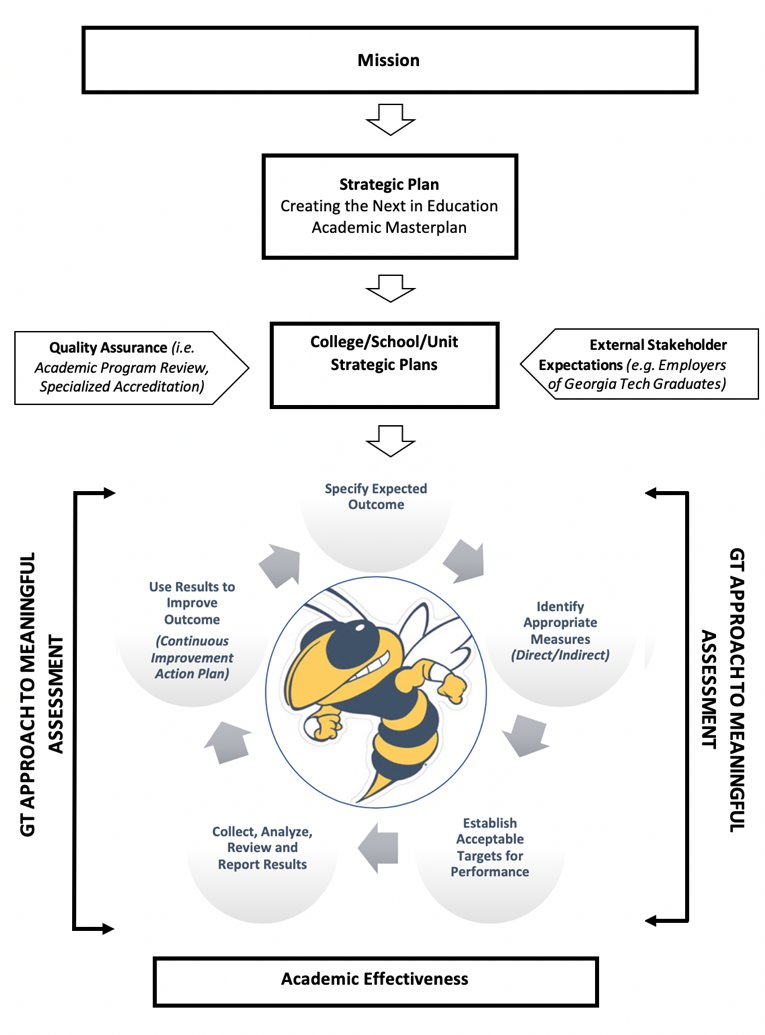GT Approach to Meaningful Outcomes Assessment
GT Academic Effectiveness Framework for Meaningful Outcomes Assessment
What is Assessment?
Assessment is a systematic process of gathering, analyzing, and interpreting evidence to determine the extent to which outcomes meet establish expectations (Suskie, 2004).
At Georgia Tech the process includes monitoring and improving the academic, administrative and student support structure that leads to the continuous quality improvement of the Institute’s academic programs and administrative and student support services.
Suskie, L. (Ed.). (2004) Assessing student learning a common sense guide. San Francisco, CA:Jossey-Bass.
GT Approach to Meaningful Outcomes Assessment
The Institute’s approach to meaningful outcomes assessment consists of the following five steps.
- Specify expected outcomes that are aligned with program goals, strategic priorities, and the Institute’s mission.
- Identify appropriate measures (i.e., direct/indirect where appropriate) to assess the outcome.
- Establish acceptable targets for performance
- Collect, analyze, review and report results
- Use results to improve outcome
The five steps do not represent a “once-and-done” process, but a continuous cycle in which assessment results are used to support sustainable improvements. Following is a visual model of the Institute’s approach to meaningful outcomes assessment.

GT Approach to Meaningful Outcomes Assessment
GT Academic Effectiveness Framework for Meaningful Outcomes Assessment
The assessment process at Georgia Tech is mission-driven. The Institute’s mission informs the strategic priorities of the institution (Creating the Next in Education, Academic Masterplan, Institute Strategic Plan). College/school/unit strategic initiatives are influenced by and designed to help move the Institute closer to the realization of the mission and strategic priorities. The strategic plans at the college/school/unit level are also influenced by internal and external stakeholders to include but not limited to employers of GT graduates, regional and specialized accrediting bodies, etc. The Institute’s approach to meaningful outcomes assessment is then used as a tool to monitor progress in a spirit of continuous improvement which drives academic effectiveness.
Following is a visual representation of GT Academic Effectiveness Framework for Meaningful Outcomes Assessment.

GT Academic Effectiveness Framework for Meaningful Outcomes Assessment
Student Learning Assessment
Student learning assessment is an ongoing process of :
- Establishing clear, measurable expected outcomes of student learning.
- Ensuring that students have sufficient opportunities to achieve those outcomes
- Systematically gathering, analyzing, and interpreting evidence to determine how well students learning matches our expectations.
- Using the resulting information to understand and improve student learning.
Suskie, L. (Ed.). (2004) Assessing student learning a common sense guide. San Francisco, CA: Jossey-Bass.
Components of Student Learning Assessment
Definition of Key Assessment Terms
|
|

